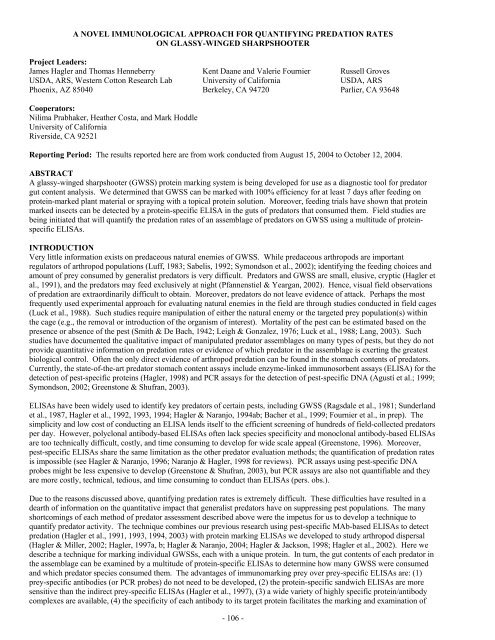Impact Of Host Plant Xylem Fluid On Xylella Fastidiosa Multiplication ...
Impact Of Host Plant Xylem Fluid On Xylella Fastidiosa Multiplication ...
Impact Of Host Plant Xylem Fluid On Xylella Fastidiosa Multiplication ...
You also want an ePaper? Increase the reach of your titles
YUMPU automatically turns print PDFs into web optimized ePapers that Google loves.
A NOVEL IMMUNOLOGICAL APPROACH FOR QUANTIFYING PREDATION RATES<br />
ON GLASSY-WINGED SHARPSHOOTER<br />
Project Leaders:<br />
James Hagler and Thomas Henneberry<br />
USDA, ARS, Western Cotton Research Lab<br />
Phoenix, AZ 85040<br />
Cooperators:<br />
Nilima Prabhaker, Heather Costa, and Mark Hoddle<br />
University of California<br />
Riverside, CA 92521<br />
Kent Daane and Valerie Fournier<br />
University of California<br />
Berkeley, CA 94720<br />
Russell Groves<br />
USDA, ARS<br />
Parlier, CA 93648<br />
Reporting Period: The results reported here are from work conducted from August 15, 2004 to October 12, 2004.<br />
ABSTRACT<br />
A glassy-winged sharpshooter (GWSS) protein marking system is being developed for use as a diagnostic tool for predator<br />
gut content analysis. We determined that GWSS can be marked with 100% efficiency for at least 7 days after feeding on<br />
protein-marked plant material or spraying with a topical protein solution. Moreover, feeding trials have shown that protein<br />
marked insects can be detected by a protein-specific ELISA in the guts of predators that consumed them. Field studies are<br />
being initiated that will quantify the predation rates of an assemblage of predators on GWSS using a multitude of proteinspecific<br />
ELISAs.<br />
INTRODUCTION<br />
Very little information exists on predaceous natural enemies of GWSS. While predaceous arthropods are important<br />
regulators of arthropod populations (Luff, 1983; Sabelis, 1992; Symondson et al., 2002); identifying the feeding choices and<br />
amount of prey consumed by generalist predators is very difficult. Predators and GWSS are small, elusive, cryptic (Hagler et<br />
al., 1991), and the predators may feed exclusively at night (Pfannenstiel & Yeargan, 2002). Hence, visual field observations<br />
of predation are extraordinarily difficult to obtain. Moreover, predators do not leave evidence of attack. Perhaps the most<br />
frequently used experimental approach for evaluating natural enemies in the field are through studies conducted in field cages<br />
(Luck et al., 1988). Such studies require manipulation of either the natural enemy or the targeted prey population(s) within<br />
the cage (e.g., the removal or introduction of the organism of interest). Mortality of the pest can be estimated based on the<br />
presence or absence of the pest (Smith & De Bach, 1942; Leigh & Gonzalez, 1976; Luck et al., 1988; Lang, 2003). Such<br />
studies have documented the qualitative impact of manipulated predator assemblages on many types of pests, but they do not<br />
provide quantitative information on predation rates or evidence of which predator in the assemblage is exerting the greatest<br />
biological control. <strong>Of</strong>ten the only direct evidence of arthropod predation can be found in the stomach contents of predators.<br />
Currently, the state-of-the-art predator stomach content assays include enzyme-linked immunosorbent assays (ELISA) for the<br />
detection of pest-specific proteins (Hagler, 1998) and PCR assays for the detection of pest-specific DNA (Agustí et al.; 1999;<br />
Symondson, 2002; Greenstone & Shufran, 2003).<br />
ELISAs have been widely used to identify key predators of certain pests, including GWSS (Ragsdale et al., 1981; Sunderland<br />
et al., 1987, Hagler et al., 1992, 1993, 1994; Hagler & Naranjo, 1994ab; Bacher et al., 1999; Fournier et al., in prep). The<br />
simplicity and low cost of conducting an ELISA lends itself to the efficient screening of hundreds of field-collected predators<br />
per day. However, polyclonal antibody-based ELISAs often lack species specificity and monoclonal antibody-based ELISAs<br />
are too technically difficult, costly, and time consuming to develop for wide scale appeal (Greenstone, 1996). Moreover,<br />
pest-specific ELISAs share the same limitation as the other predator evaluation methods; the quantification of predation rates<br />
is impossible (see Hagler & Naranjo, 1996; Naranjo & Hagler, 1998 for reviews). PCR assays using pest-specific DNA<br />
probes might be less expensive to develop (Greenstone & Shufran, 2003), but PCR assays are also not quantifiable and they<br />
are more costly, technical, tedious, and time consuming to conduct than ELISAs (pers. obs.).<br />
Due to the reasons discussed above, quantifying predation rates is extremely difficult. These difficulties have resulted in a<br />
dearth of information on the quantitative impact that generalist predators have on suppressing pest populations. The many<br />
shortcomings of each method of predator assessment described above were the impetus for us to develop a technique to<br />
quantify predator activity. The technique combines our previous research using pest-specific MAb-based ELISAs to detect<br />
predation (Hagler et al., 1991, 1993, 1994, 2003) with protein marking ELISAs we developed to study arthropod dispersal<br />
(Hagler & Miller, 2002; Hagler, 1997a, b; Hagler & Naranjo, 2004; Hagler & Jackson, 1998; Hagler et al., 2002). Here we<br />
describe a technique for marking individual GWSSs, each with a unique protein. In turn, the gut contents of each predator in<br />
the assemblage can be examined by a multitude of protein-specific ELISAs to determine how many GWSS were consumed<br />
and which predator species consumed them. The advantages of immunomarking prey over prey-specific ELISAs are: (1)<br />
prey-specific antibodies (or PCR probes) do not need to be developed, (2) the protein-specific sandwich ELISAs are more<br />
sensitive than the indirect prey-specific ELISAs (Hagler et al., 1997), (3) a wide variety of highly specific protein/antibody<br />
complexes are available, (4) the specificity of each antibody to its target protein facilitates the marking and examination of<br />
- 106 -











